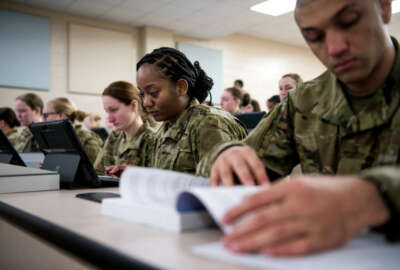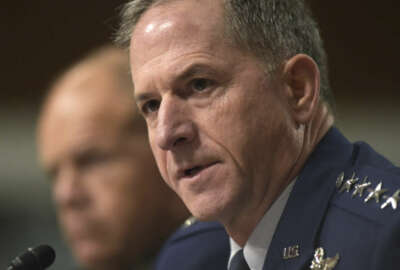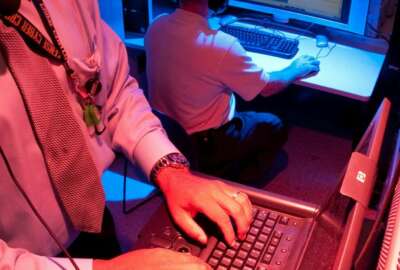
Simulated pilot training has come a long way
Pilot training outside of the cockpit, in a simulator, is known as synthetic training. It's getting more sophisticated and realistic.
Pilot training outside of the cockpit, in a simulator, is known as synthetic training. It’s getting more sophisticated and realistic. For more, at this week’s Sea Air Space Conference, the Federal Drive with Tom Temin spoke with an Air Force synthetic training officer with the Air Combat Command, Major Joseph Silverio.
Interview transcript:
Joseph Silverio In traditional sense, it’s everything that’s not flying an actual airplane, for an aviator like myself. And so traditionally, that would be your SIMS. You’re simulator training newer emerging technologies, allowing synthetic adversaries or projected adversaries into the live arena, or some type of VR into the cockpit as the avenue or most of what I’m trying to pursue.
Tom Temin So the simulator itself has really come a long way then, it sounds like from the days when there was just a blue screen outside the window and it looked like sky.
Joseph Silverio Absolutely. We still have those levels of trainers. So your your basic HOTAS, hands on throttle and stick, and button pushing trainer with a single, maybe touch screen in front of you all the way up to your full 360 degree dome clamshell, as they call them. Not the greatest fidelity on the visuals, but that gives you the most immersive training. And then, to the latest iteration of scenario and environment generation, it’s called the Joint Simulation Environment that the Navy is developing. So we’re looking to also adapt that to Air Force platforms.
Tom Temin Got it. The first time someone comes in and they are deemed to be qualified as an aviator, that is someone inside an airplane. Does that include simply the left seat pilot or copilots or different jobs aboard that might be, say, a transport?
Joseph Silverio Yes. So having a fighter background myself, F-15E was a strike eagle in the Air Force. That would be my perspective. But I do have a slight understanding of how crew mentality works. There are, when it comes to simulator training, I’m being brought up to speed on front end and back end trainers. So for your crew, as are your heavies, they have the pilot training simulator, and then they also have the crew essentially simulator for your controllers here. And tell whoever is on the back of that airplane doing their job, they have both sets of those simulators, sometimes working in conjunction, otherwise sometimes working just one piece of that.
Tom Temin And the simulators move, right? They have pitch, roll, diving.
Joseph Silverio For most fighters, no. And that’s one of the limitations as we want it to be as immersive and possible. But for most fighters, no, you don’t get that G-loading, as we call it. That’s the one thing that you can’t replicate in the SIM, that you can in the in the jet. Not quite sure on all that crew heavies, but I have been in one that does have some motion. It’s not 360 degrees or complete but there are crew to place heavy airplane that do have some motion to them.
Tom Temin And so what do people gain from synthetic training? What are the limitations of it to the point where you got to get behind them in a real cockpit at some point?
Joseph Silverio Right.
Tom Temin I was going to say behind the wheel, that’s probably not the right word.
Joseph Silverio I think it would have gone well. I think everybody would’ve understood that. But yeah, that is a really great question. The biggest limitation that we have in the library, and so flying the airplane to actually get training, coming up really is the airspace size limiting both our weapons range and the adversary weapon range. So we can’t really train to as far apart as we need to for realistically anymore. The other pieces of that’s where the SIM currently has an advantage, is just the adversary replication. So whether we don’t have the intel or the airplanes to accurately and operationally represent the enemy airplanes or even enemy ground threats, which are also limited by the airspace size over the ground that they take up. So with those three pieces, those are kind of the advantages of doing things in the simulator or trying to bring that technology into the live arena for a live synthetic, they call it live virtual, constructive blended training, whatever you want to call it, bringing us synthetic advantages into the live arena. So you still get to that decision making under G, for fighter pilots. But while you meet the operationally representative of the red forces.
Tom Temin Yeah. And there are companies that have old fighters that they’ve refurbished that will play adversary for you. But that’s expensive, isn’t it?
Joseph Silverio Correct. I don’t have the details on the numbers of our adversary air contracts, but yeah, it’s not cheap. And the next portion of that would be trying to get more advanced, more modern fighters for them, which would obviously be more expensive.
Tom Temin But that level of training where someone is actually flying the plane and there is an actual flying adversary, that’s the very end of training when most of the work has been done in either solo flight or in simulation and synthetic.
Joseph Silverio To me that’s more continuation training. So once you, I guess, toward the end of your training continuum, what you are combat mission ready, your everyday training would be up against a live adversary to keep your skills at the top level that you need them to, to be able to go to combat as required.
Tom Temin And while someone is undergoing synthetic training, what kind of metrics are you gathering about that person?
Joseph Silverio So that’s another avenue that the Air Force Research Laboratory has been pursuing for a number of years, and they call Mission Essential competencies. So in a traditional fighter flight debrief, the instructor would have to pull all those, look at the tapes, look at certain points in time, to do we shoot our missiles on time? Do we not go into the enemy threat range? And we have to pull that out manually. With some technologies that Air Force Research Laboratory is pursuing, AI machine learning or simulator. We were able to pull that data automatically, especially out of the simulator. If we can put that technology into the live arena as well, that would be great. It would save time and debrief, obviously. And then as a combat aviators or operator essentially, is building those metrics, building those competencies. It can be a constant back and forth update of, well, we don’t really do that anymore. Here’s our new set of skills that we need to be up on top of.
Tom Temin And besides the reaction times and whether they steer correctly and operate the engine and all the myriad of tasks, do you also take measurements, again, in synthetic training of their bio psychological responses and that type of thing?
Joseph Silverio Not at the leading edge of the cap. Some of those technologies haven’t made it into the jets in the cockpits yet, but that is how, from my understanding, how some of the undergraduate pilot training pipelines have accelerated graduation. Gone from a 11 to 13 month process to graduate somebody, just ready to fly any Air Force airplane. They’ve incorporated biometric feedback, analysis of things the cockpit to record. Either eye movement or vital signs to determine kind of the status of human being. And we’ve been able to, I don’t know the current pipeline on a program like that, but I think it has dramatically shortened the undergraduate side of training to get people into their final [Mission Design Series (MDS)].
Tom Temin And how much time in SIM training or in simulator training or in synthetic training, does a airman air person need before you let them into a cockpit? Or does it happen simultaneously?
Joseph Silverio For undergraduate pilot training, as well as your FT, you you’re following training your basic course, once you get to your actual your combat ready airframe. Typically you’ll do anywhere from three weeks to three months of just ground school academics, engines, systems, hydraulics, whatever you need to do just to understand the airplane. As you’re kind of going through that, you’ll get introduced to the simulator so you can find all the buttons, figure out how to turn the engines on, turn the lights on, all those different types of things. And then once you have at least a basic understanding of that, some understanding of tactics or procedures in the airplane, how you fly it, how you take off, how you land, how you fly a pattern, then we let you get near. So it’s anywhere three to six months, in some type of ground school with simulators. And then you actually get into an airplane.
Tom Temin And how close are the trainer fighters to the actual fighters? So training jets, I should say.
Joseph Silverio The T-38 is the both the undergraduate pilot training phase three for fighter bomber track pilots and aviators. It’s 50 years old, or actually more than 50 years old, I believe. One of the oldest jets the Air Force has an inventory, so we are pursuing a newer fighter looking at the. I believe it’s going to be the T7 that is coming out.
Tom Temin That’s been in development for a while.
Joseph Silverio Yes. So it takes a while to get new airplanes, new trainers. But we understand it’s a very old airframe, just like my background, this Strike Eagle, 40 years old, the Eagles itself 50 years old. So continuing to drive get new airplanes out there. So the T-38 itself, a very basic trainer, two engines, very small, very small wings. So you learn how to basically go fast, make decisions at very high speeds. And then between your T-38 and then whatever your final fighter MDS is, that’s really it. T-38 introduction of fighter fundamentals, and then you get into your MDS and that’s where you go back to ground school, learn this new airplane, learn how to fly this new airplane, and then go out to your operational squadron for mission qualification training.
Tom Temin And the first time you pilot an F-15, F-16 or an F-18, whatever the case might be, what’s that like the first time the controls are in your hand and it’s real?
Joseph Silverio For myself, as a [Weapons Systems Officer (WSO)] in the back seat, controlling the airplane is not my primary duty, but it is. I remember the first time I flew a T-38 and moving that fast was a quite a unique experience, an exhilarating experience. Then graduating to the F-15, it was about the same thing. It’s a big giant window, 360 class office. And that’s, I don’t think there’s any better job.
Tom Temin All right. And one thing I always wondered, when you fire a missile, do you feel it from the jet?
Joseph Silverio Yes, absolutely. So the the largest air to ground ordnance that I have dropped into a £2,000 weapon. And you can feel that. Not on the stick, not on the controls, the time it comes off, but I’m sure that that changes the aerodynamics of the airplane. And there’s just a lot of weight coming off the airplane that’s going to change the way it maneuvers. Even in the back seat, you can feel the thunk of the airplane letting go.
Copyright © 2025 Federal News Network. All rights reserved. This website is not intended for users located within the European Economic Area.
Tom Temin is host of the Federal Drive and has been providing insight on federal technology and management issues for more than 30 years.
Follow @tteminWFED





